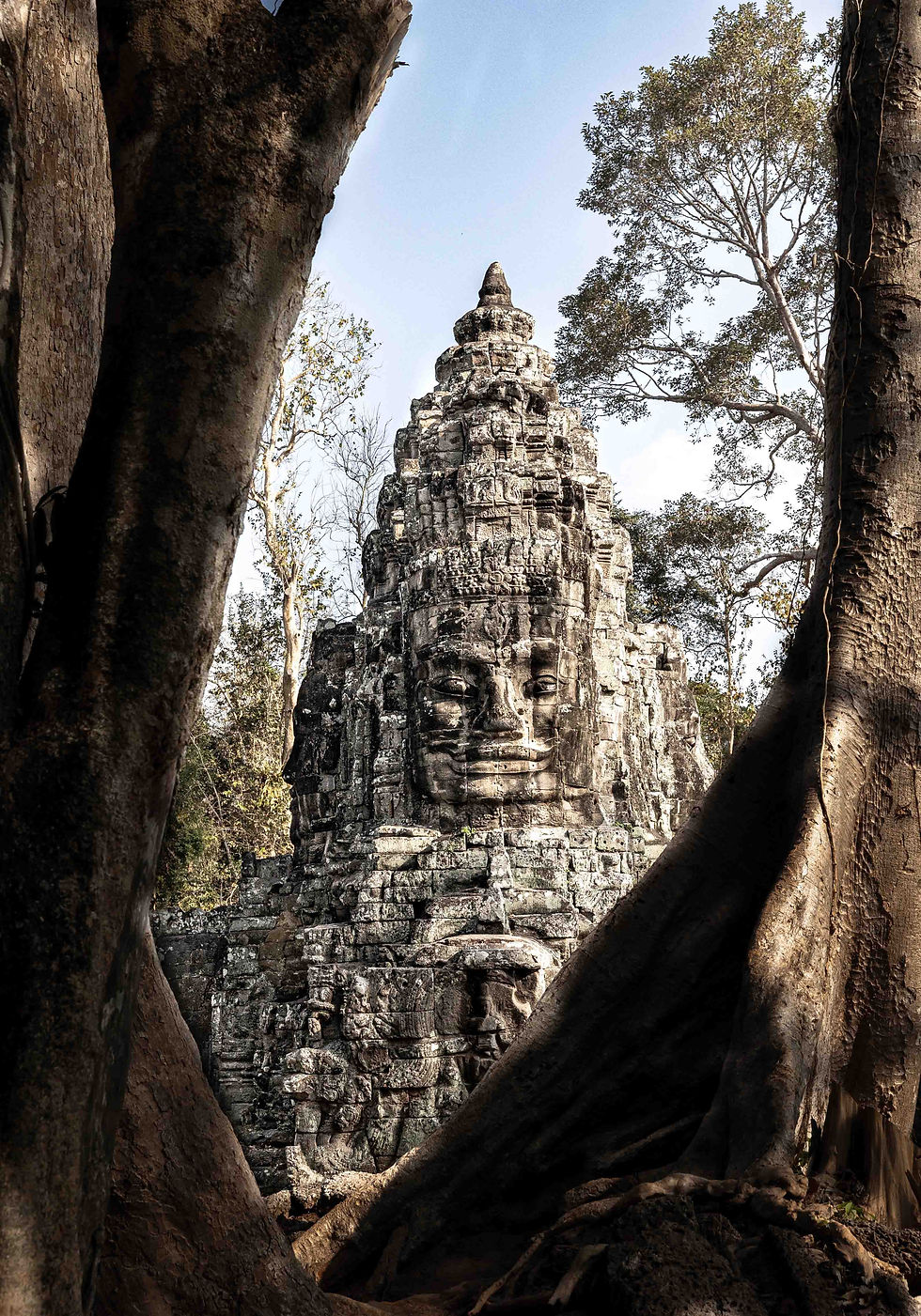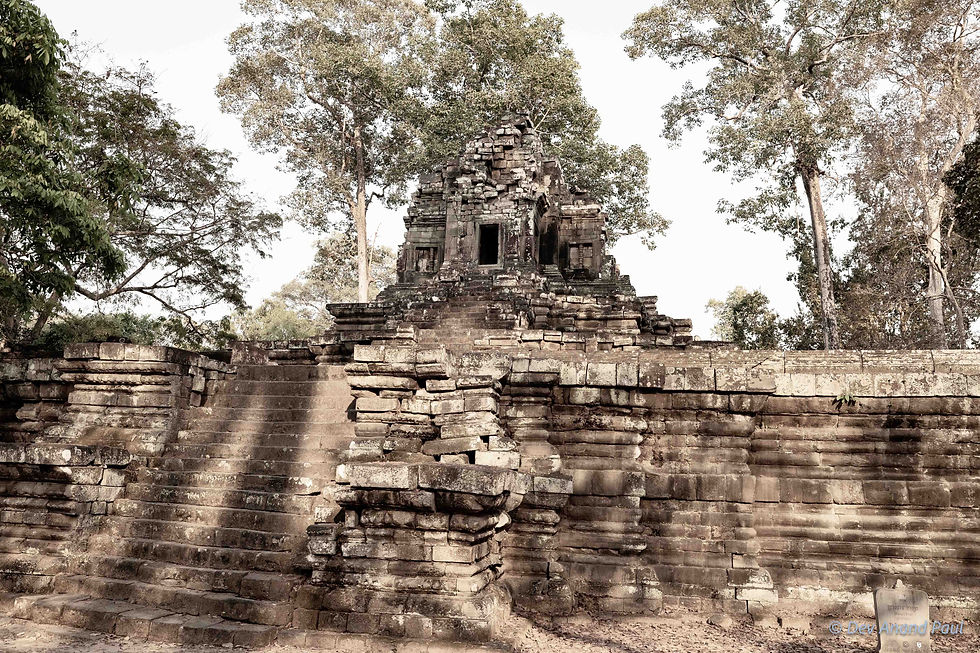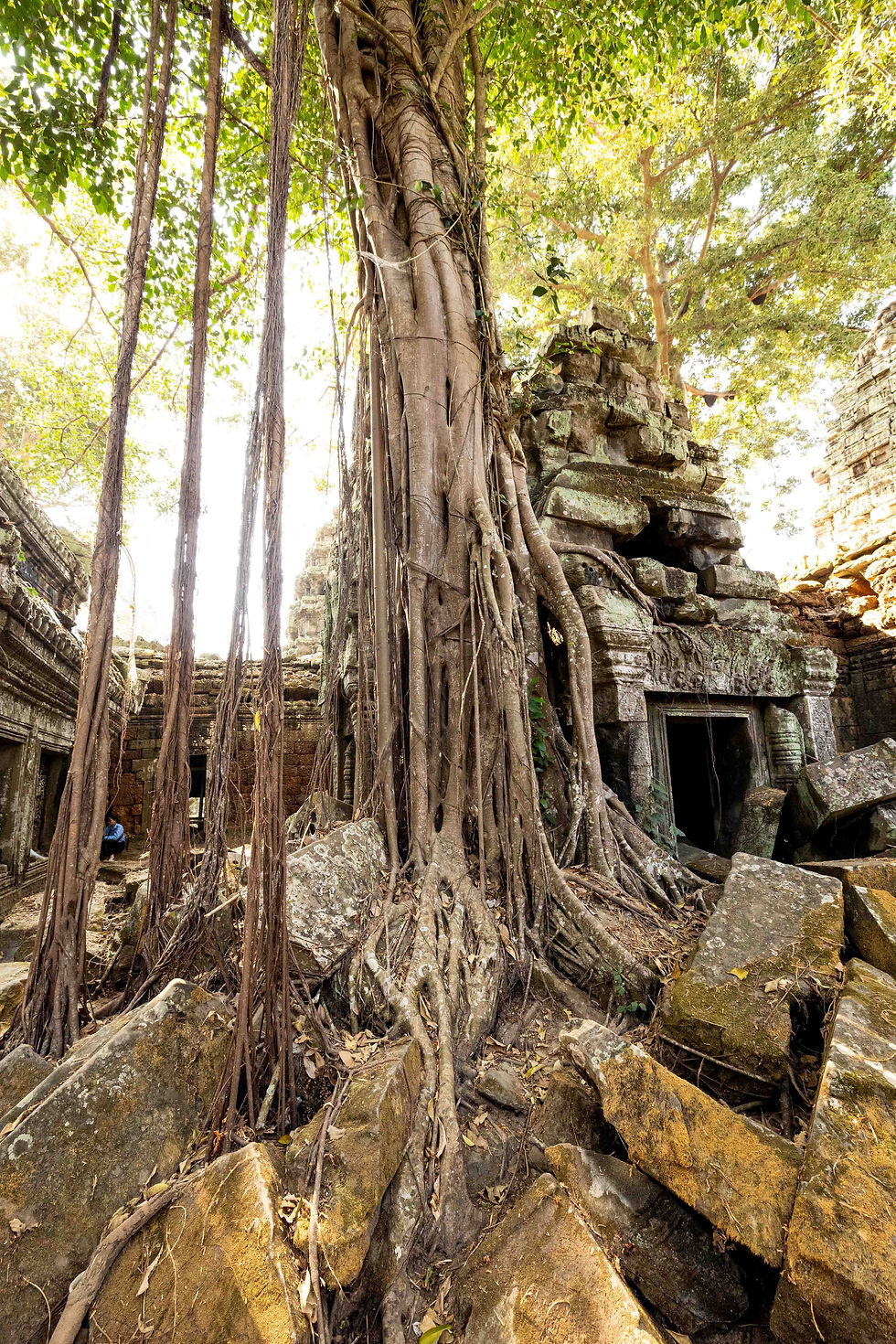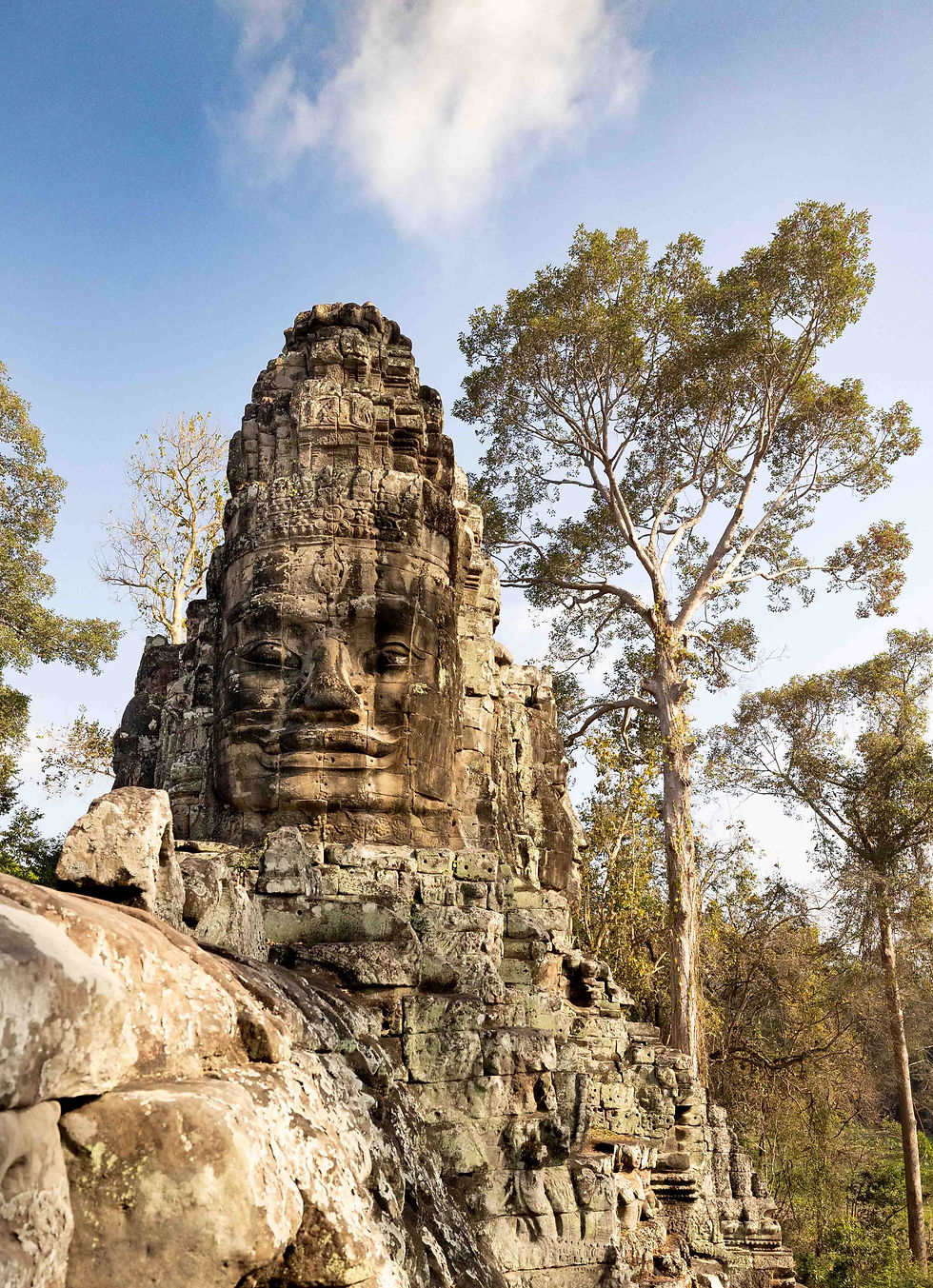Travel Tips for Visiting Angkor Wat
- devanandpaul
- Jul 27, 2024
- 8 min read
Updated: Nov 13, 2024

I grew up reading about Angkor Wat, one of the largest religious monuments in the world, during my childhood. I was captivated by the images of its majestic towers rising above the surrounding forests. I often dreamed of standing before these mammoth structures and marvelling at the artistry that has withstood the test of time. My dream came true in February 2024. The sprawling temple complex stands as a testament to the Khmer Empire’s architectural brilliance. Its grandeur and the intricate bas-reliefs will forever be etched in my memory.

History
Angkor emerged in the 9th century as the capital of the kingdom of Kambuja, present-day Cambodia. Strategically located along the monsoon sea route to China, it became a hub for trade between India and China, facilitating the introduction of Hinduism and Buddhism to Southeast Asia. The Khmer culture, which reached its zenith in Angkor, blossomed from the Mon-Khmer people’s exposure to Indian religious, cultural, and commercial influences.
Known as a ‘lost city’, Angkor was abandoned to the jungle in the mid-15th century after invasions from Thailand and Vietnam. The city was rediscovered four centuries later. By then only its stone structures had survived, as the jungle overtook and destroyed nonstone elements.

Today, the ruins of Angkor provide insights into the Khmer teachings about the meaning of life from a thousand years ago. Influenced by India but rooted in universal human experience, these teachings are expressed through visual analogies in its temples.
Best time to visit Angkor Wat
Cambodia has two main seasons: dry (November to March) and monsoon (rainy season; June to October). The best time to explore Angkor Wat is during the dry season, offering cool, dry weather with clear skies and minimal rainfall. However, this period is also peak tourist season, hence larger crowds and higher hotel prices. April and May are extremely hot and dry, making temple exploration uncomfortable. During monsoon, Angkor Wat can be wet and muddy.
Visa
Most visitors require a visa, obtainable upon arrival at the airport or land border, or online in advance. Tourist visas cost US$30 and e-visas $35.
Hotel and transport
Siem Reap is a modest-sized city that features hotels, local dining spots, and tourist sites in proximity. The primary modes of transport are tuk-tuks and taxis, readily available for hire by the hour or for individual trips.
Entry ticket to Angkor Archaeological Park
An Angkor Pass is required to visit Angkor Wat and the Angkor Archaeological Park. Passes for 1, 3, or 7 days can be purchased at the ticket office or online through the Angkor Enterprise Portal. Multi-day passes need not be used on consecutive days; the 3-day pass is valid for 10 days, and the 7-day pass for 30 days. Tickets are non-transferable and cannot be changed or upgraded after purchase.
Photography
Angkor Wat presents an ideal setting for photographers, offering boundless opportunities to capture stunning images. Optimal moments for photographing the temples are at sunrise and sunset, when the soft, warm light envelops the structures in a golden hue.
\

Cuisine
Siem Reap is famous for its delicious Khmer cuisine. It also has many cosmopolitan eateries. Rice is their staple food. Local restaurants near the temples offer Cambodian vegetable dishes, along with rice, and popular noodle dishes. Amok, a standout Khmer dish featuring meat or fish cooked in coconut milk and spices, is worth trying. The city also offers a vibrant nightlife, with numerous bars and clubs to suit various tastes.
Currency
Although the official currency is the riel, US dollars are commonly accepted across the country. Credit cards are also widely accepted at many establishments, including hotels, restaurants, and shops.
Bargaining
Clothing and souvenir stalls typically expect negotiation, so don’t hesitate to haggle. Approach the interaction with friendliness, viewing it as an opportunity for engagement. It is important to recognize that Cambodia is an impoverished country. Although Khmer is the official language, English is widely spoken in tourist areas.
Safety
Known for its safety and friendliness, Siem Reap offers a welcoming environment for tourists. Scams do occur at the temples at times, including fake police officers asking for bribes, fake monks seeking donations, and individuals demanding extra fees for temple entry. Also, watch out for pickpockets posing as curious tourists, who try to steal your belongings. Avoid supporting children selling souvenirs, books, or postcards.
Dress code
Appropriate attire is necessary for temple visits; so ensure your shoulders and knees are covered. Additionally, it is advisable to wear comfortable shoes, as there will be extensive walking.
Temple visits
Licensed guides are readily available for hire near the entrances. They also offer comprehensive tours, should you need in-depth historical context. A customized tour is well worth the extra cost. If you are travelling solo or on a budget, consider joining a group tour.
The easiest way to navigate the Angkor complex is by hiring a tuk-tuk, either through your hotel or finding one on the street and negotiating the price. The temples are too spread out to explore on foot. You can also rent a motorbike or bicycle. Tuk-tuks are the most convenient option, as the drivers know the area and can take you to lesser-known temples as well. Moreover, they often have chilled drinking water waiting for you when you return, exhausted.

I suggest using the Grab taxi app for tuk-tuk rides, as the fares are predetermined. You can also use the same app to check the standard rate before negotiating, ensuring a fair deal for both you and the driver.
The best way to see the major temples of Angkor is by following 2 tour routes: the Small Circuit and the Grand Circuit.
The Small Circuit, also known as Little Circuit, is ideal for 1-day pass holders, as it covers the key temples in the central area of Angkor Archaeological Park, including Angkor Wat.
The Grand Circuit, or the Big Circuit, is an extension of the Small Circuit route and covers the outer temples in the Angkor Archaeological Park.
There is another set of temples, called the Roluos Group, which comprises 4 or 5 temples outside the Angkor Archaeological Park. These are located near Roluos, a small town about 15 km southeast of Siem Reap along the highway to Phnom Penh.
How long should you spend at Angkor Complex
A common question for many visitors is, how long should one spend at the Angkor Complex? While a quick 1- or 2-day visit might seem sufficient for zipping between temples in a tuk-tuk, it often means enduring the midday heat and crowds. Allocating more time allows you to escape the throngs, explore quieter and more remote temples, and appreciate the intricate architectural details.
If you are planning a bespoke tour, allocate 4–5 days to explore the Angkor Complex in a relaxed manner. If you have 4 days, you can see the main sights of the Angkor Archaeological Park and also visit temples farther afield, like the jungle-clad Beng Mealea. For photographers, extra days provide flexibility for capturing perfect shots. If you have a week, consider a boat trip on the Tonlé Sap Lake, where villages on stilt and floating markets offer fascinating insights into Cambodia’s traditional life. If you have only 1 day to spare, start with sunrise at Angkor Wat, then visit Bayon, Baphuon, Phimeanakas, Thommanon, Chau Say Tevoda, Ta Keo, Ta Prohm, and Banteay Kdei.
I had dedicated 6 days to explore the temples with a customized guide, focusing on photography and in-depth architectural study. In what follows, I suggest a plan to cover the Small Circuit and Big Circuit temples in 3 days, and an additional day for exploring temples in surrounding villages. If you have only 3 days, I recommend you follow the first 3 days of the itinerary.
Day 1 | Day 2 | Day 3 | Day 4 |
Small circuit | Small circuit | Big circuit | Roluos |
Angkor Wat | Phnom Bakheng | The North Gate of Angkor Thom | Beng Mealea |
South Gate of Angkor Thom | Thommanon | Preah Khan | Bakong |
Preah Pithu | Chau Say Tevoda | Banteay Prei | Lolei |
Spean Thmor | Ta Keo | Neak Pean | Preah Ko |
Bayon | Ta Prohm | Ta Nei | Prasat Prei Monti |
Baphuon | Banteay Kdei | Ta Som |
|
Phimeanakas | Srah Srang | East Mebon |
|
Terrace of the Elephants | Prasat Kravan | Pre Rup |
|
Terrace of the Leper King | Krol Ko Temple | ||
Leak Neang Temple |
Day 1
Angkor Wat

A stunning architectural masterpiece renowned for its intricate bas-reliefs and spires—holds spiritual significance in Khmer culture.
South Gate of Angkor Thom

A grand entrance to the ancient Khmer capital, adorned with majestic stone faces.
Preah Pithu

A cluster of small temples within the Angkor Thom complex—offers serene and lesser-known spots for exploration.
Spean Thmor

An ancient bridge—holds historical significance as a vital link in the Angkorian road network.
Bayon


The central temple of Angkor Thom—famed for the smiling faces carved on stone towers.
Baphuon


A monumental temple dedicated to the Hindu god Shiva, nestled within Angkor Thom—features intricate carvings and restored architecture.
Phimeanakas

A pyramid-shaped temple steeped in myth and history, located within Angkor Thom—offers panoramic views from its summit.
Terrace of the Elephants


A ceremonial platform and royal viewing area within the Angkor Thom complex—boasts intricate carvings of elephants.
Terrace of the Leper King


A terrace adorned with carvings and statues—holds enigmatic tales of ancient Khmer royalty and ceremonies.
Day 2
Phnom Bakheng

A hilltop Hindu temple—offers panoramic views of the surrounding landscape and is renowned for its picturesque sunset vistas.
Thommanon

An exquisite temple built in Angkor style—offers intricate carvings and serene surroundings for contemplation.
Chau Say Tevoda


The twin temple of Thommanon—showcases intricate architectural details and Hindu mythology in its carvings.
Ta Keo

A pyramid-style temple—an impressive yet unfinished monument with steep staircases and panoramic views.
Ta Prohm


A famous temple built without mortar, now overtaken by nature—tree roots have intertwined with temple ruins, evoking a sense of awe. The temple appears in the movie Lara Croft: Tomb Raider, hence also called Tomb Raider Temple or Angelina Jolie Temple!
Banteay Kdei

Another temple engulfed by nature—offers a peaceful and atmospheric setting with moss-covered stones and towering trees.
Srah Srang

An Angkor-era reservoir that served as a ceremonial bathing site—offers tranquil sunset views amidst lush surroundings.
Prasat Kravan


A temple known for its 5 brick towers adorned with unique bas-reliefs—offers insight into Khmer architecture and artistry.
Day 3
The North Gate of Angkor Thom


A majestic entrance to the ancient Khmer capital, adorned with intricate carvings and monumental towers.
Preah Khan



A sprawling temple complex engulfed by jungle foliage—evokes a sense of mystique and grandeur with its labyrinthine corridors and towering stone structures.
Banteay Prei
A lesser-known temple—offers exquisite carvings and serene surroundings.
Neak Pean


An Angkor-era water temple situated on an artificial island—provides a tranquil retreat with its serene ponds and symbolic sculptures.
Ta Nei

Ta Nei Temple features intricate carvings and a tranquil atmosphere. It remains a serene and less-visited site compared to other Angkor temples.
Ta Som

A hidden gem amidst the Angkor ruins, featuring picturesque tree root¬–encased ruins and intricate carvings—offers a serene atmosphere for exploration.
East Mebon

A majestic temple mountain dedicated to the Hindu god Shiva—boasts impressive stone elephants and stunning views of the surrounding landscape.
Pre Rup


A towering temple pyramid—offers panoramic views of the Angkor complex and surrounding countryside, making it a popular spot for sunrise and sunset.
Krol Ko Temple

An ancient sanctuary nestled amidst lush vegetation—showcases intricate carvings and architectural elements, providing a glimpse into Khmer craftsmanship.
Leak Neang Temple
A small yet charming temple ruin—features unique architectural elements and serene surroundings, offering a peaceful retreat.
Day 4
Beng Mealea

An enigmatic temple ruin enveloped by dense jungle—offers a mysterious and adventurous experience with its sprawling, unrestored structures and hidden carvings.
Bakong

The first temple mountain constructed by the Khmer Empire—stands as a significant and well-preserved example of early Khmer architecture.
Lolei

A small but historically significant temple dedicated to the Hindu god Shiva—renowned for its intricate brick carvings.
Preah Ko

A temple honouring the ancestors of the Khmer king Indravarman I—celebrated for its well-preserved sandstone carvings.
Prasat Prei Monti
One of the earliest Khmer temple structures—characterized by its 3 brick towers.
Visiting time
Angkor Wat and Srah Srang are favoured locations for sunrise viewing and welcome visitors from 5 a.m. to 5:30 p.m.
Phnom Bakheng and Pre Rup attract visitors for both sunrise and sunset views and are open from 5 a.m. to 7 p.m.
All others are open from 7:30 a.m. to 5:30 p.m.
Whether you have your own itinerary or are joining a prearranged trip, there is an abundance of sights and activities to enjoy, making careful planning essential.
Related posts:




Dear Dev,
Beautifully drafted! Your travel tips are precise and insightful.
I was unaware of the dress code, and the details you have shared on the best season and duration are invaluable.
Many visitors only realise after arriving that Angkor Wat is not just a single temple but an entire town, requiring over three days to explore fully.
Your suggestion to bring extra camera batteries is spot on, considering the countless panels, sculptures, birds, insects, and plants worth capturing. The three-day itinerary you have shared is well thought out and practical.
Additionally, it would be beneficial to mention the challenges vegetarian tourists might face in finding suitable food options in the area.
Needless to add, as always, your photos are…
Fantastic dev - so detailed and traveler friendly blog!